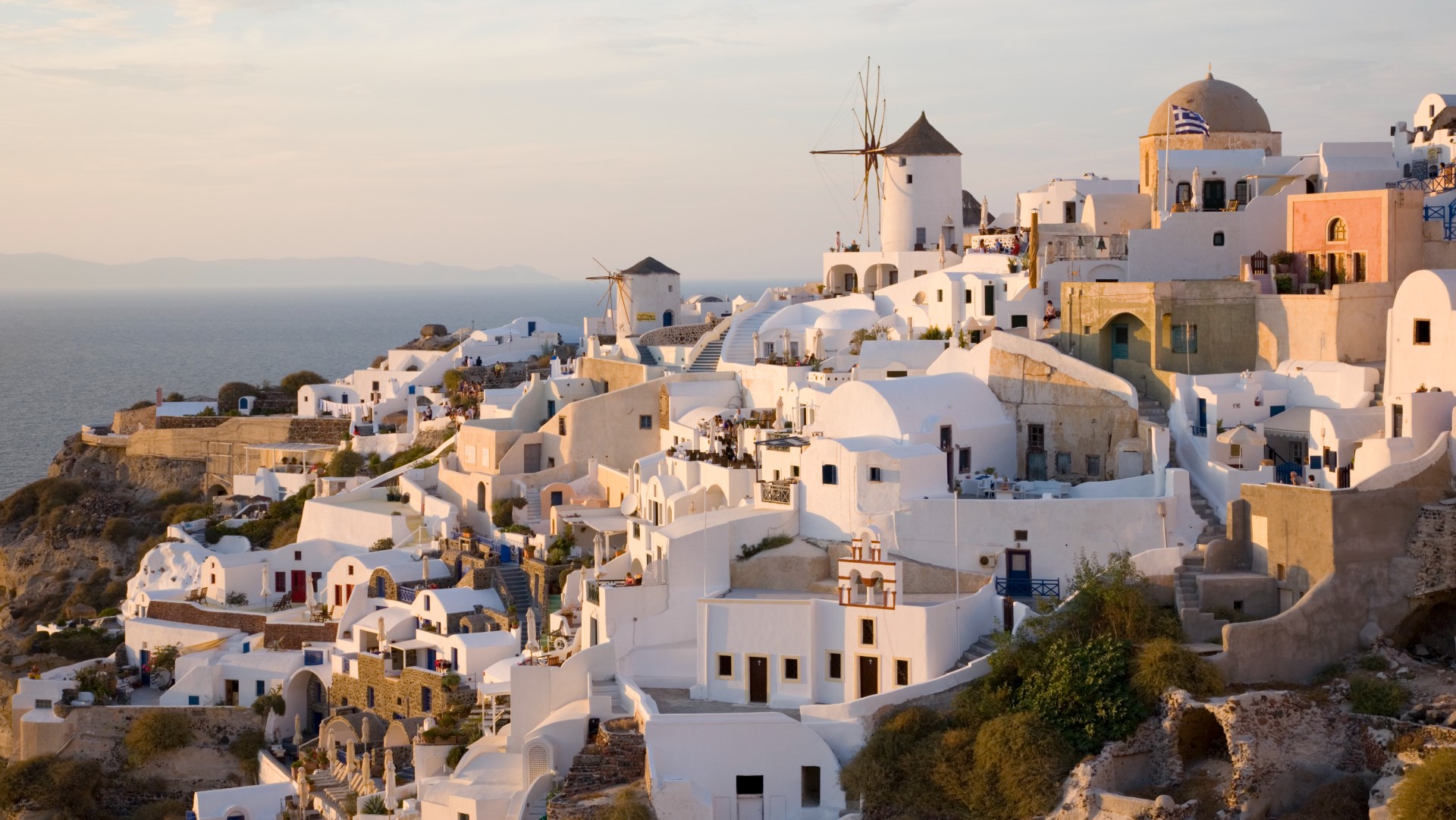White paint: a cool solution for climate change?
Cooling properties of new ultra-white formula could offset worsening global warming

Brilliantly whitewashed houses are a familiar sight in hot countries, from Morocco to Greece. In fact, white-painted roofs “have been used to cool buildings for centuries”, said The Guardian.
But against the backdrop of record-high global temperatures, scientists and governments are increasingly looking to new forms of white paint as a cheap, accessible cooling method.
This year, a new ultra-white formula invented by researchers at Purdue University, Indiana received an Innovation Award in sustainability for its potential to combat extreme heat. According to the team’s modelling, covering just 1% of the Earth’s surface with the paint could be enough to offset the total effects of global warming.
The Week
Escape your echo chamber. Get the facts behind the news, plus analysis from multiple perspectives.

Sign up for The Week's Free Newsletters
From our morning news briefing to a weekly Good News Newsletter, get the best of The Week delivered directly to your inbox.
From our morning news briefing to a weekly Good News Newsletter, get the best of The Week delivered directly to your inbox.
It could be just in time, with the Met Office confirming that last month was the hottest UK June on record, with an average mean temperature of 15.8C.
It also puts us on track for even more extreme weather to come. “Alongside natural variability, the background warming of the Earth’s atmosphere due to human-induced climate change has driven up the possibility of reaching record-high temperatures,” said Paul Davies, Met Office climate extremes principal fellow and chief meteorologist.
Does white paint work?
As far back as the 1970s, “scientists and manufacturers had been developing whiter and whiter paints to help reflect sunlight and keep buildings and other surfaces cool”, said Gizmodo.
Commercially available white paints keep buildings cooler than dark paints because they reflect 80-90% of the sun’s rays. However, most contain titanium dioxide, which absorbs about 10% of sunlight, so they cannot reduce temperatures below the surrounding level.
A free daily email with the biggest news stories of the day – and the best features from TheWeek.com
Homes painted with solar-reflective paint were one degree cooler than those with uncoated roofs, according to a 2020 study by the Indian Institute of Public Health.
A similar Indian study in 2016 found that a white roof reduced indoor air temperature, on average, by 2.1C. The results “prove that white roof has a significant effect in reducing the indoor air temperatures in buildings”, it said.
Former UN Secretary General, Ban Ki-moon, told BBC News in 2019 that painting a building’s roof white could reduce the internal temperature by as much as 7 degrees.
That figure was disputed by Anjali Jaiswal, of the US-based Natural Resources Defence Council, which oversaw a pilot project in Ahmedabad City, western India, where more than 3,000 city rooftops were painted with white lime in 2017.
He said cool roofs could lower indoor temperatures by 2-5C, compared with traditional roofs.
Project Drawdown, a UK climate solutions charity, estimated that white roofs and green (planted) roofs could avoid between 600m and 1.1bn tonnes of carbon dioxide by 2050, which is “roughly equivalent to two to three years of the UK’s total annual emissions”, said The Guardian.
So how is this new paint different?
Over the past decade, researchers “have found greater success with multilayered coatings that incorporate tiny particles of varying sizes”, said Scientific American, “to reflect many wavelengths of light.”
In 2014, a group from Stanford experimented with layers of reflective surfaces in order to cool surfaces. But these processes were far more intensive and costly “than simply slapping on some paint”, the site said.
Inspired by the work, Purdue University researchers developed a new paint – using different compounds that don’t absorb UV light – with a hybrid approach that still incorporates the reflective aspect.
Its formula reflects back 98.1% of sunlight and solar radiation, at the same time as deflecting infrared heat. Because it absorbs less heat than it emits, a surface painted with it cools below the ambient temperature.
Using this paint to cover a roof area of about 1,000 square feet could result in a cooling power of 10 kilowatts, researchers found. “That’s more powerful than the air conditioners used by most houses,” said Purdue’s Xiulin Ruan, lead inventor and professor of mechanical engineering.
The ultra-white paint, recognised last year as the world’s whitest by Guinness World Records, “has plenty of competition from other researchers”, said Scientific American, but manufacturers would have to address keeping the paint white over time.
Other concerns have been raised over the price of the paint, with high concentration of pigment necessary for the relatively thick layers, as well as the availability of the compounds needed.
Where is white paint in use?
The technique is already being used on modern city buildings, such as in New York City, which in 2019 whitened more than 10 million square feet of rooftops, according to BBC News.
In some of India’s most heat-intensive slums, a non-profit organisation called Mahila Housing Trust (MHT) has been helping residents paint their roofs white since 2009, installing 30,000 cool roofs in nine states, according to BBC Future.
The charity found that white solar-reflective paint was the most accessible cooling solution it had tried “because of its comparatively low price”, Bhavna Maheriya, MHT’s programme manager, told the news site.
The “simple solution” of ultra-white roof paint keeps the worst of the heat out of slum homes, said BBC Future.
Harriet Marsden is a senior staff writer and podcast panellist for The Week, covering world news and writing the weekly Global Digest newsletter. Before joining the site in 2023, she was a freelance journalist for seven years, working for The Guardian, The Times and The Independent among others, and regularly appearing on radio shows. In 2021, she was awarded the “journalist-at-large” fellowship by the Local Trust charity, and spent a year travelling independently to some of England’s most deprived areas to write about community activism. She has a master’s in international journalism from City University, and has also worked in Bolivia, Colombia and Spain.
-
 Film reviews: ‘Marty Supreme’ and ‘Is This Thing On?’
Film reviews: ‘Marty Supreme’ and ‘Is This Thing On?’Feature A born grifter chases his table tennis dreams and a dad turns to stand-up to fight off heartbreak
-
 Political cartoons for December 14
Political cartoons for December 14Cartoons Sunday's political cartoons include a new White House flag, Venezuela negotiations, and more
-
 Heavenly spectacle in the wilds of Canada
Heavenly spectacle in the wilds of CanadaThe Week Recommends ‘Mind-bending’ outpost for spotting animals – and the northern lights
-
 Death toll from Southeast Asia storms tops 1,000
Death toll from Southeast Asia storms tops 1,000speed read Catastrophic floods and landslides have struck Sri Lanka, Indonesia, Thailand and Malaysia
-
 Can for-profit geoengineering put a pause on climate change?
Can for-profit geoengineering put a pause on climate change?In the Spotlight Stardust Solutions wants to dim the sun. Scientists are worried.
-
 ‘Like a gas chamber’: the air pollution throttling Delhi
‘Like a gas chamber’: the air pollution throttling DelhiUnder The Radar Indian capital has tried cloud seeding to address the crisis, which has seen schools closed and outdoor events suspended
-
 How will climate change affect the UK?
How will climate change affect the UK?The Explainer Met Office projections show the UK getting substantially warmer and wetter – with more extreme weather events
-
 Can the UK do more on climate change?
Can the UK do more on climate change?Today's Big Question Labour has shown leadership in the face of fraying international consensus, but must show the public their green mission is ‘a net benefit, not a net cost’
-
 Did Cop30 fulfil its promise to Indigenous Brazilians?
Did Cop30 fulfil its promise to Indigenous Brazilians?Today’s Big Question Brazilian president approves 10 new protected territories, following ‘unprecedented’ Indigenous presence at conference, both as delegates and protesters
-
 Can the world adapt to climate change?
Can the world adapt to climate change?Today's Big Question As the world gets hotter, COP30 leaders consider resilience efforts
-
 Taps could run dry in drought-stricken Tehran
Taps could run dry in drought-stricken TehranUnder the Radar President warns that unless rationing eases water crisis, citizens may have to evacuate the capital